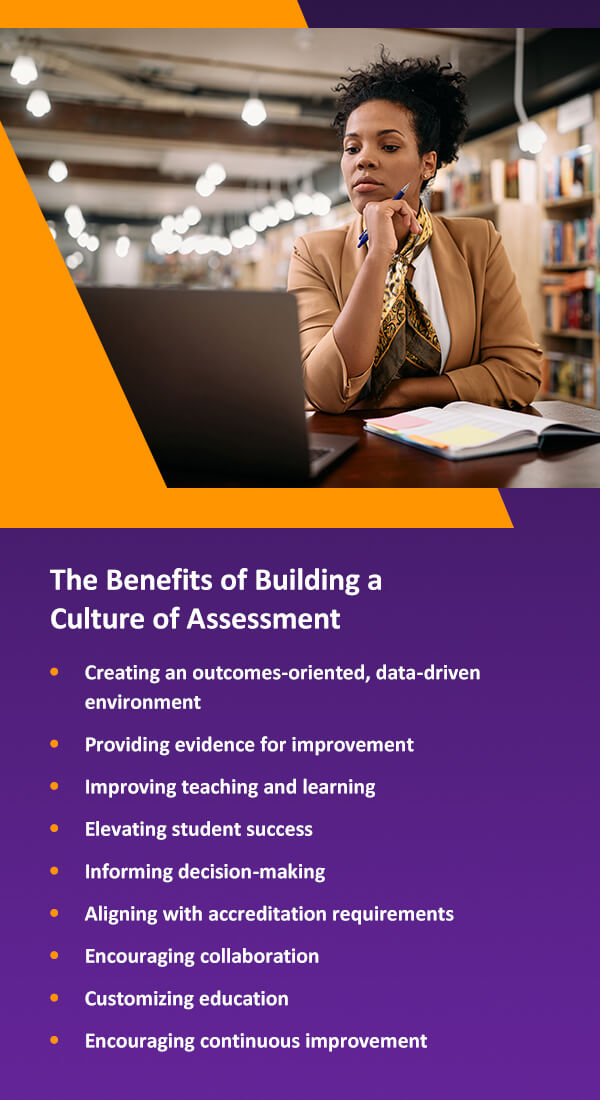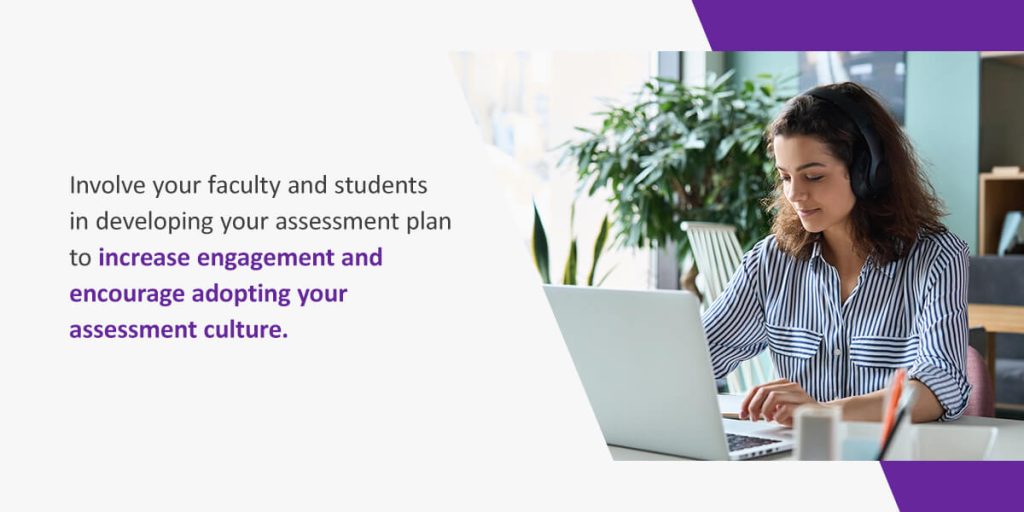




Many higher education institutions have realized the value of conducting an ongoing assessment of their programs. Using masses of student data to inform decision-making has the potential to reengage the student body, faculty, and stakeholders. In fact, assessment is a powerful tool in education today, and knowing how to build a culture of assessment in education is critical.
The COVID-19 pandemic changed the face of assessment in higher education, emphasizing student success and engagement to improve student enrollment and retention. In addition, higher education institutions had to reexamine their objectives, integrating innovative technology to get a more accurate picture of student and faculty satisfaction, learning outcomes, and student readiness to enter the workplace.
A culture of assessment in higher education is an institutional mindset and environment where continuous assessment and improvement sit at the heart of teaching, learning, and administrative processes. It goes beyond creating an assessment program — it’s an environment where decisions are based on reliable insights to deliver the best possible outcomes. Assessment culture relies on administrators, decision-makers, faculty, and students taking a genuine interest in the results they produce, and how these results relate to broader institutional and student outcomes.
At the core of a culture of assessment is a desire for continuous improvement accompanied by the necessary action. In the digital age, higher education institutions have access to a wealth of data, and cultivating a culture of assessment involves using that data to gain insights into how programs, processes, and services boost student success and contribute to institutional goals. Creating an assessment culture consists in taking a systematic approach to gathering and analyzing data to understand and improve programs and processes.
In an assessment culture, institutions move students from a discernable starting point towards meaningful outcomes that persist long after they’ve completed their education. It considers variables like the learning process to establish priorities, identify areas for improvement and foster collaboration throughout the entire institution.

Building a culture of assessment involves a complete paradigm shift for higher education institutions. Higher education leaders must innovate, but many institutions face resistance to change. Understanding the considerable advantages of building an assessment culture to combat this resistance is essential. Some of the many benefits include:
Although the advantages of an assessment culture are significant, implementing one requires a measured and systematic approach with minimal internal resistance. However, when implemented correctly, the right combination of culture and innovative technology can revolutionize teaching and learning, elevate student success, and improve administrative processes.
Understanding how to build a culture of assessment is essential for higher education. Building such a culture requires a systematic, data-informed approach to ensure widespread change throughout your institution. Take the following steps to start building an assessment culture unique to your institution:
Approaches to assessment in education have changed significantly in recent years, such as shifting away from summative and towards formative assessments throughout student courses. On a broader level, traditional student assessment focused on results in a vacuum. Today, assessment focuses more on thinking, performance, and skills and less on memorized knowledge.
Years of research and best practices have taught us that aligning assessment practices with institutional outcomes and goals is essential to support students in fulfilling their academic and career potential. Assessment must go beyond measuring student memory and focus instead on improving the student experience. In simple terms, modern assessment has two objectives — to measure student skills and knowledge and to enhance teaching and learning.
Establishing a culture of assessment starts with a change in institutional mindset, where assessment takes on a broader meaning and has the power to bring about far-reaching success.

Before implementing changes in your assessment process, remember that assessment measures progress against predefined goals. Your institution must gather the relevant stakeholders and define specific, measurable, achievable, realistic, and time-bound (SMART) goals.
Goals are your broad themes, institutional priorities, and general successes your institution focuses on. They’re linked to your overall purpose or “why.” From there, define outcomes — more concrete outlines of your institution’s goals and how you will know when you’ve earned it. Your outcomes should also be tied to action-oriented verbs, focused on the future, linked to your mission, and connected to Bloom’s Taxonomy.
Ensure you have clearly defined academic and non-academic outcomes to guide your assessment process, so you can measure your progress and identify opportunities for improvement.
While defining goals can lead to frustration, faculty, administration, students, and stakeholders must speak the same language when defining their assessment culture. A common language avoids misunderstanding at the most basic level. Everyone involved in the assessment must come together and develop a list of assessment terms, along with working definitions.
This glossary of terms must be available to the entire academic community. Language is a powerful tool and over time, everyone in the institution will adopt these terms, fostering collaboration at the grassroots level and instilling a powerful sense of shared culture.
Curriculum mapping provides valuable insights into your program and assesses whether it can meet your newly defined outcomes. Your curriculum map should show the connections between the expected results of academic programs and the courses where this learning should occur.
A curriculum map should provide a strong foundation for your assessment process so you have clear markers to look for when measuring your progress. Conduct a curriculum committee review of individual courses, so you can examine them individually.
With this information, faculty and program chairs can understand how their courses fit into the institution’s bigger picture and confirm outcomes are covered in the relevant programs. With a clear roadmap, administrators, faculty and students know what is expected of them as they progress through the program.
Students are the heart of higher education, and a culture of assessment involves students as more than recipients. Instead, they should actively participate in the assessment process. Student satisfaction is vital for institutions and the students themselves. You can empower students to participate in an assessment culture in various ways, including co-creating assessment criteria and peer assessments.
In addition, advisors should encourage students to set individual goals and reflect on their progress, allowing them to create personalized learning paths aligned with their careers. Involving students in your culture shift from the outset can increase student satisfaction, engagement, and ownership of their academic journey. Developing critical thinking and other skills they can carry into their careers is also essential.
Assessment culture should permeate throughout the entire institution. Although it is primarily a faculty-driven process, a fundamental culture shift requires everyone on board to work toward a shared objective. Stakeholders and decision-makers must support integrating assessment technology and empower students to participate in learning.
Backed by stakeholder support, faculty members must take ownership of their assessment culture. In the same way, you involve students from the outset and involve the faculty, as they are the energy behind your program implementation. In short, with the support of faculty, you can take your assessment from theoretical to practical.
Consult with your faculty on creating your assessment program, as they are the people who take the leading role in the implementation.
For your faculty to contribute the most they can to your assessment culture, they must have access to professional development opportunities. Some faculty members may take care of their ongoing education, but establishing a continuous professional development program is essential for widespread adoption, understanding, and increased faculty engagement. Prioritize assessment clarity and understanding, and allow faculty to attend assessment workshops.
Providing faculty members with assessment workshops demonstrates your commitment to assessment, and the effects are more meaningful than professional education. Workshops spark conversation, and your faculty will adopt assessment language. In time, faculty members will be confident in their assessment culture and understand that it is achievable, accessible, and engaging.
Assessment is everyone’s initiative, including your administration and the president of the institution. Assessment goes hand in hand with accountability, and presidents are vital in keeping assessment efforts honest. Administrators must keep abreast of student satisfaction, assess institutional effectiveness, and use assessment data to inform resource allocation and other strategic decisions.

While assessment plans are fluid, they must be realistic and cost-effective. You may want to assess multiple learning objectives, but practically, the task would be too time-consuming. Consider the capabilities of individual faculty members, and how they can tailor their assessment objectives to fit in with their other commitments.
Embedding assessment practices into the coursework is essential to prevent adding to the faculty workload. Faculty members can integrate different types of assessment into routine course implementation, and back the assessment process with purpose-built technology to work through the data and deal with the number of student course evaluation responses.
Involve your faculty and students in developing your assessment plan to increase engagement and encourage adopting your assessment culture.
Assessments generate meaningful data, but institutions must prioritize analyzing it to know where to focus their future efforts and drive change. In a culture of assessment, reviews are regular and detailed. Assessment of student learning outcomes is an essential factor in program review.
Your review process is likely unique to your institution. It should focus on growth, improvement, and accountability, going beyond accreditation requirements. In addition to student learning outcomes, there are many other areas to assess. Comprehensive reviews can extend to assessing institutional effectiveness as a whole, which involves everyone involved with your institution. Evaluating the climate of an institution, for example, is an effective method of pinpointing opportunities for improvement via direct student and faculty feedback.
Measuring your progress can be complex. A culture of assessment relies on continuous feedback, so your measurements should be as simple as possible. Keep the following tips in mind to simplify your measurements:
For a culture of assessment to permeate an entire institution, the process must continue beyond gathering and interpreting results. Avoid faculty providing results and then not hearing anything more about them. Instead, celebrate your successes and show everyone involved the importance of success. Acknowledgment and appreciation are critical to show everyone involved that the institution values their efforts. Share your accomplishments with faculty and students to increase engagement, satisfaction, and commitment to further assessment-based initiatives.
It’s as important to share your failures to foster an assessment culture of transparency. Discussing what went wrong and why is helpful, as you can often identify minor adjustments that could make a big difference to the end result.

Developing a culture of assessment is essential for higher education institutions to meet students where they are and drive successful outcomes. However, adopting an assessment culture requires access to meaningful, data-driven insights, and a continuous improvement mindset. Using a digital assessment solution can accelerate adoption rates, and simplify the assessment process, making an assessment culture a reality.
Watermark Planning & Self Study is a streamlined system for gathering, reflecting, and acting on meaningful data, helping institutions drive significant change and creating a culture of assessment. We can help you gain insights at every level and align your actions with objectives. Request a demo today to learn more about how we can help you build your assessment culture.





























































































































































































































































































































































































